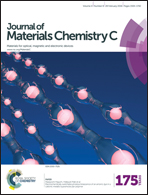Preparation of 3D graphene networks and a C dot grafted graphene hybrid by new methods for improving the photovoltaic performance of CdS/CdSe quantum dot sensitized solar cells†
Abstract
In this paper, we firstly report the preparation of 3D graphene networks (GNs) by sonication-free liquid-phase exfoliation (LPE) and C dot grafted graphene (CD–G) hybrids. The 3D GNs and CD–G hybrids were incorporated into TiO2 photoanodes for improving the photovoltaic performance of CdS/CdSe quantum dot sensitized solar cells (QDSSCs) due to their unique structures and excellent conductivities. When the amounts of incorporation are 1.6 wt% for GNs and 2.0 wt% for CD–G, η (photoelectric conversion efficiency) exhibited improvements from 4.04% to 4.37% and 4.69%, respectively. The remarkable improvements in η are predominantly ascribed to the fact that the electron transport from TiO2 to graphene decreased the probability of recombination of charge carriers and ultimately improved the photoelectric conversion efficiency. For CD–G/TiO2, the electron transport from C dots to graphene may strengthen the effect. This work demonstrates a possibility of fabricating superior photoanodes for enhancing the performances of QDSSCs by designing graphene nanoarchitectures with unique structures and morphologies as the dopants.


 Please wait while we load your content...
Please wait while we load your content...